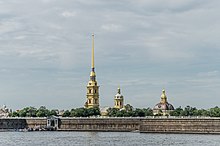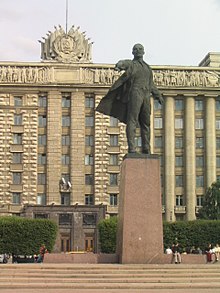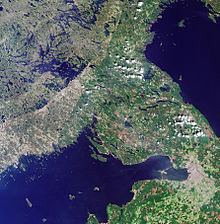Saint Petersburg
![]()
Leningrad is a redirect to this article. For other meanings see Saint Petersburg (disambiguation) or Leningrad (disambiguation).
Saint Petersburg (Russian Санкт-Петербург Saint-Peterburg; also St. Petersburg for short, local nickname Piter after the original Dutch-inspired name Санкт-Питербурх Saint-Piterburch) is Russia's second-largest city after Moscow and the fourth-largest in Europe, with a population of 5.35 million as of 2018.
Saint Petersburg is located in the northwest of the country at the mouth of the Neva River into the Neva Bay at the eastern end of the Gulf of Finland of the Baltic Sea and is the northernmost city of one million inhabitants in the world. The city was founded in 1703 by Peter the Great on marshy land near the sea to enforce Russia's claim to access to the Baltic Sea. In 1712 it became the capital of Russia. In 1918, the Bolsheviks moved their government to Moscow. For over 200 years it bore its present name; from 1914 to 1924 it was called Petrograd (Петроград), and from 1924 to 1991, in honor of Lenin, the founder of the Soviet Union, Leningrad (Ленинград) was its name ( the ![]() three names as well as the city's short name, Piter, commonly used in everyday Russian speech).
three names as well as the city's short name, Piter, commonly used in everyday Russian speech).
The city was the capital of the Russian Empire from the 18th to the 20th century, is an important cultural centre throughout Europe and is home to the most important Russian port on the Baltic Sea.
The historic city centre with 2300 palaces, magnificent buildings and castles has been registered as a UNESCO World Heritage Site since 1991 under the collective term Historic Centre of Saint Petersburg and Related Groups of Monuments. In this diversity, St. Petersburg is comparable worldwide only with Venice.
With the 462 meter high Lakhta Center, the highest building in Europe is located in the city.

Peter and Paul Fortress. In the middle the two gilded towers of the Peter and Paul Cathedral.

The bronze horseman on Senate Square: Monument to Peter the Great

Lenin statue in Leningrad. The building in the background was originally intended to be the seat of the city administration; for size comparison: on the bottom right are people
Geography
Location description and effect of the proximity to the Baltic Sea
The city, originally built in a marshy area, lies at the mouth of the Neva into the Gulf of Finland. The city area covers about 1,431 km² including the suburbs such as Peterhof and Pushkin, which have administratively belonged to Saint Petersburg since 1999, of which about 10 percent is water. The city consists of 42 islands. Originally there were more, but numerous canals between them have since been filled in. The city itself had to be built two to four meters above sea level. This is because the mouth of the Neva River is roughly at sea level, and the first builders encountered groundwater at a depth of just a few centimetres. The banks were fortified with granite blocks early on, which not only protects Saint Petersburg from the water, but contributes a lot to the specific cityscape. Alexander Pushkin described it as: "The city dresses in granite".
Due to its location a few meters above sea level, the city is always threatened by floods. Kronstadt, located on a nearby island, is a reference point for the sea level gauge. The reference area of this Kronstadt gauge is about 15 centimetres higher than the Amsterdam gauge valid in Germany and is a reference point for altitude in large parts of Eastern Europe and was in the New Federal States until 1993. The city has often been a victim of flooding. Official statistics count 295 floods since the city was founded (as of 2003), 44 of them since 1980 alone. The worst floods were in 1824 (200 to 500 deaths, depending on the statistics) and 1924.
Climate
Saint Petersburg lies on the same latitude as the cities of Oslo and Stockholm, the southern part of Alaska and the southern tip of Greenland. It has a typical maritime climate, the weather is changeable and can change within a short time. Summers are comparatively mild with average temperatures of 19 to 22 °C, but in winter average temperatures drop to -4 to -8 °C. The maxima are +37 °C in summer (2010) and -42 °C in winter (1941 and other, though uncertain, data). Due to its location, it does not get completely dark at night at the time of the summer solstice (so-called "white nights").
| Monthly average temperatures and precipitation for St. Petersburg
Source: Roshydromet, wetterkontor.de | ||||||||||||||||||||||||||||||||||||||||||||||||||||||||||||||||||||||||||||||||||||||||||||||||||||||||||||||||||||||||||||||||||||||||||||||||||||||||||||||||||||||||||||||||||||||||||||||||||||||||||||||||||||||||||||||||||||||||||||||||||||||||||||||||||||||||||||||||||||||||||
Effect of the Neva
With a length of 74 kilometres, the Neva is a very short river, but one of the most water-rich rivers in Europe. It gets up to 600 meters wide and has a strong current. The river covers about 28 kilometres of its route within the city area of Saint Petersburg.
Until the 19th century, the biology of the relatively shallow bay of the Neva alone was sufficient to clean the wastewater from Saint Petersburg. Even today, the wastewater from the industrial city of 5 million inhabitants accounts for only 2 percent of the total volume of water in the Neva. In the mid-19th century, however, the first waterborne epidemics, such as cholera and typhoid fever, broke out. During the typhus epidemic of 1908 alone, about 9000 people died. A change in the conditions of discharge helped to alleviate the problem for the time being from 1910 onwards. In the 1950s and 1960s, the sharp increase in population caused the sewage problem to escalate again. This was compounded by the increased pollution of the Neva River along its course - it drains Lake Ladoga, on the shores of which are numerous factories and which itself receives the dirty water of numerous Russian cities via its tributaries. A sewage treatment plant has been built, but 25 to 30 percent of urban wastewater still reaches the river and the bay untreated. The bay is home to mainly freshwater but also some brackish water inhabitants. The biological system is highly variable and suffers from human interference. Together with Moscow, Petersburg is considered one of the most polluted cities in Russia.
Since 1978, the Soviet government has had the Petersburg Dam built across the Neva Bay to protect the city from flooding. Unlike most river floods, the floods on the Neva are not caused by the river bringing more water from its upper reaches, but by westerly winds pushing into the Gulf of Finland and preventing the water from flowing away or, in extreme cases, reversing the direction of flow.
The construction was temporarily demolished in the late 1980s for environmental reasons: The dam disrupted the circulation of coastal water, large parts of the water stood still, and water quality dropped significantly. Fears were that the entire bay could turn into a swamp. However, the dam has continued to be built since 1990 with Dutch aid and support from the European Investment Bank and was completed in 2010. However, as the environmental arguments against the dam remain, the issue remains very controversial in the city.

Satellite image of Petersburg and surroundings: From left to right Gulf of Finland, Saint Petersburg, Lake Ladoga. In the upper left corner the border to Finland, in the bay in front of Petersburg the island fortress Kronstadt and from there the dam in front of Petersburg.
Politics
Saint Petersburg is the administrative seat of the Leningrad Oblast and the Northwest Federal District. Within Russia, however, the city - just like Moscow - is an independent administrative subject. The executive branch is headed by the city's governor, who is directly elected for a four-year term. The legislature, the Legislative Assembly, consists of 50 full-time members who are also elected for four-year terms. The Speaker of the House is equal in protocol to the Governor.
In 1996 it was Vladimir Yakovlev who replaced Anatoly Sobchak. He presented himself on several occasions as an ideologically unattached pragmatist. Sobchak, on the other hand, was a strict reformer of the post-communist era who generated a lot of animosity in the city because of his radical free-market course. He refused several times to dismiss Vladimir Putin on corruption charges while the latter was still working in the city government. Putin organized Sobchak's unsuccessful 1996 election campaign.
Yakovlev did not stand for re-election in October 2003. His successor after these elections was Valentina Matviyenko. She was the favorite of Putin and the Russian government. Matviyenko resigned in August 2011 and in September, as a representative of St. Petersburg's executive branch, became chairwoman of the Russian Federation Council and thus the holder of the third highest state office in Russia.
The governor from 2011 to 2018 was Georgy Poltavchenko. The son of a naval officer transferred to Leningrad from Azerbaijan, he received training at the KGB High School in Minsk in 1979-1980. He then took on various assignments with the KGB and the KGB's successor service, the FSB. From 1992 to 1993 he was head of the tax investigation department and from 1993 to 1999 chief of the tax police in Saint Petersburg.
President Vladimir Putin appointed him the Russian President's Representative in Leningrad Oblast in 1999, and later Governor General for Central Russia. In this capacity, he was a member of the Russian Security Council. On August 30, 2011, he was appointed acting governor of Saint Petersburg and proposed to the city parliament for election. Out of 52 deputies of the legislative assembly, 37 voted for him. On 31 August 2011, he was inaugurated into office. From October 3, 2018 until the gubernatorial election in September 2019, Alexander Beglow served as acting governor. On September 8, 2019, he was elected to office with nearly two-thirds of the vote.
The city became known internationally and in Germany politically, among other things, through the Petersburg Dialogue - the regular German-Russian talks in the city - and the Petersburg Committee of Soldiers' Mothers, which regularly protests against the war in Chechnya and against violence in the army. In July 2006, Saint Petersburg also hosted the annual G8 summit, as Russia took over the rotating presidency of the Group of Eight in 2006. In 2013, the meeting of the Group of Twenty major industrialised and emerging economies was held in Saint Petersburg on 5 and 6 September.

The former governor of St. Petersburg Georgy Poltavchenko

St. Mary's Palace, seat of the St. Petersburg Legislative Assembly (Sakonodatelnoje Sobranije) in the city center
Questions and Answers
Q: What is the population of Saint Petersburg in 2015?
A: The population of Saint Petersburg in 2015 was over five million people.
Q: Where is Saint Petersburg located?
A: Saint Petersburg is located in northwestern Russia, near the Gulf of Finland of the Baltic Sea.
Q: What is Saint Petersburg known for?
A: Saint Petersburg is known for being a major port, connecting with the world's shipping paths through the Neva River and the Baltic. It is also known for being the second biggest city in Russia and having a designated World Heritage Site called The Historic Centre of Saint Petersburg and Related Groups of Monuments.
Q: What is the name of the World Heritage Site in Saint Petersburg?
A: The name of the World Heritage Site in Saint Petersburg is The Historic Centre of Saint Petersburg and Related Groups of Monuments.
Q: How does Saint Petersburg connect with the world's shipping paths?
A: Saint Petersburg connects with the world's shipping paths through the Neva River and the Baltic.
Q: What language is spoken in Saint Petersburg?
A: Russian is the main language spoken in Saint Petersburg.
Q: What is the significance of Saint Petersburg's location near the Gulf of Finland?
A: Saint Petersburg's location near the Gulf of Finland is significant because it provides access to the Baltic Sea which is an important waterway for international shipping.
Search within the encyclopedia